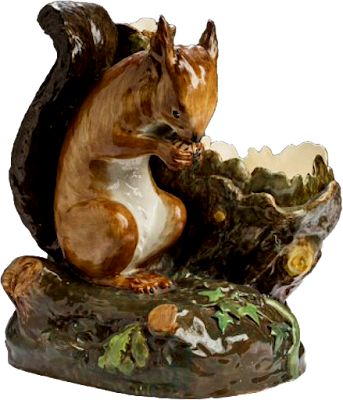 |
| Etruscan Ivory Magen David soap box |
Over the years this particular Etruscan majolica piece has unfortunately been misunderstood due to the presence of the Star of David finial. What contemporary viewers bring to the item is a modern understanding of the Star of David as a symbol of the Jewish faith. When the item was created in the 1880s however, this symbolism did not exist, at least not in the United States or anywhere else outside of Central Europe. At the time the Magen David hexagram was most frequently seen in the U.S. in churches and in Masonic imagery as a symbol of good luck.
The Star of David has been a popular symbol in many cultures from the earliest of times with multiple meanings ascribed to it. It is believed to have originated in Egypt. In Hinduism the triangle pointing down is said to represent female sexuality, with the triangle pointing upward representing male sexuality. Their combination symbolizes unity and harmony. It has appeared in the iconography of witchcraft, the Druids and Arabic magic. In alchemy, the two triangles symbolize fire and water representing the reconciliation of opposite forces. In the Middle Ages the two triangles were seen as water and heaven to indicate a harmony of heaven and earth. It was sometimes used as an emblem of alcoholic libation. It also appeared frequently on churches as a symbol of the messiah, but rarely in synagogues or on Jewish ritual objects. The Star of David also appears in the architecture of Mormon places of worship, where it symbolizes the union of heaven and earth, with God reaching down to man and man reaching up to God.
The earliest known Jewish use of the hexagram was as a seal in the 6th century B.C. but it did not represent the Jewish people in this context. It was the menorah that served as the primary Jewish symbol from antiquity until the post-Renaissance period. In the 17th Century the symbol was adopted by certain groups in central Europe as a symbol of Judaism but it was not until the late 19th Century that the Magen David began to gain association with Judaism in Eastern Europe. It was in 1897 with the International Zionist Conference that the star was chosen as an international representation of the Zionist movement.
The Etruscan Magen David soapbox was created in the 1880's as part of the Etruscan Ivory toilet set. It consisted of eight pieces: the soapbox with cover and liner; wash basin; pitcher; toothbrush holder; mouth cistern; chamber pot with cover; dresser mug; and dresser pitcher. The soap was the only piece in the set that had the Star of David on it but all of the pieces bore an overall design of upward and downward facing triangles. Most pieces were decorated in a combination of different color mottled glazes like the one shown below but some were decorated in the Venicene manner of enamel decorated earthenware like the example at the top of the post. All pieces are marked with the Etruscan Ivory circular logo.
 |
| Etruscan Ivory majolica Magen David soapbox |
For further reading on the history of the Magen David we refer you to The Six Pointed Star by Dr. O.J. Graham. For more information on the Etruscan toilet set we refer you to our book on Etruscan Majolica: The Definitive Reference on the Majolica of Griffen, Smith & Company.






























.jpg)




























